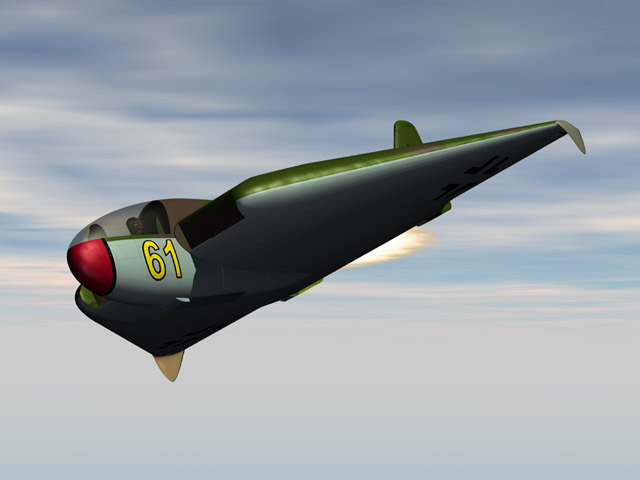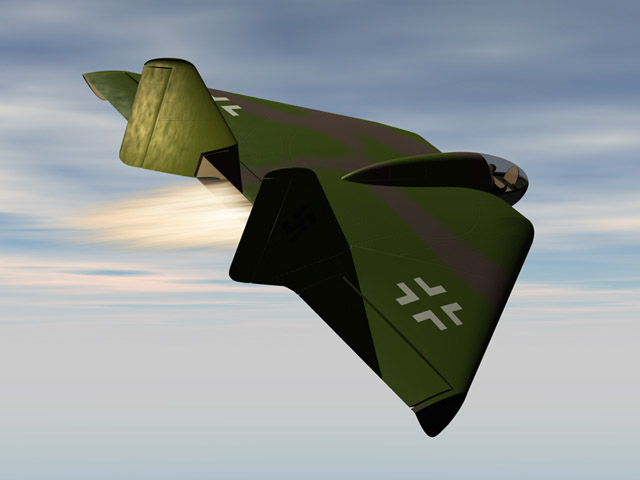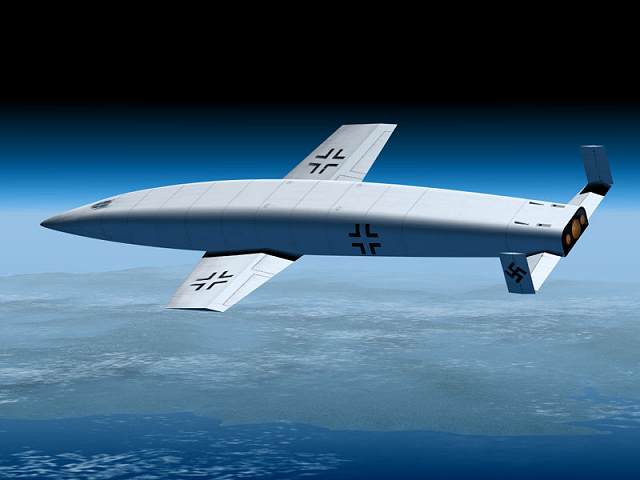At the dawn of the atomic age, scientists began work on what might have been the nastiest weapon ever conceived.
The Flying Crowbar
Once it switched from booster rockets to nuclear power, Pluto would have been a danger to friend and foe alike.
Those who came of age during the era of Three Mile Island and Chernobyl are probably too young to remember the happy days when "our friend the atom" promised electricity too cheap to meter and cars that would run forever without a fill-up. With atom-powered subs like the Nautilus cruising under the polar icecap in the mid-1950s, could anyone doubt that atom-powered rocketships, airplanes, and even automobiles would be far behind?
A funny thing happened to that dream on its way to reality: Americans discovered radiation. Project Orion, a futuristic atom bomb-powered rocketship, was grounded in 1963 when the Nuclear Test Ban Treaty forbade atomic explosions in outer space (see "A Spaceship Named Orion," October/November 1988). A nuclear-powered bomber never got off the runway after the Air Force started advertising for pilots past child-rearing age. Later, Congress learned that if such a bomber crashed, the site would become "uninhabitable." Uninhabitable?
Less than a decade after the debut of the Eisenhower administration's pro-nuclear power "Atoms for Peace" campaign, nuclear energy no longer meant cheap power and strawberries the size of footballs but man-eating ants and Godzilla.
Fatefully, Sputnik was launched when the dream of the omnipotent atom was still very much alive. Realizing that the Soviets were ahead in missiles, Americans became concerned that they might be ahead in anti-missile missiles as well. To counter that threat, Pentagon planners decided they needed an unmanned atomic bomber or a nuclear-powered cruise missile able to fly below enemy defenses.
What they came up with was SLAM, for Supersonic Low-Altitude Missile. SLAM was to use a revolutionary new type of propulsion: nuclear ramjet power. The project to build the weapon's nuclear reactor was given the code name "Pluto," which also came to refer to the weapon itself.
SLAM's simple but revolutionary design called for the use of nuclear ramjet power, which would give the missile virtually unlimited range. Air forced into a duct as the missile flew would be heated by the reactor, causing it to expand, and exhaust out the back, providing thrust.
Pluto's namesake was Roman mythology's ruler of the underworld -- seemingly an apt inspiration for a locomotive-size missile that would travel at near-treetop level at three times the speed of sound, tossing out hydrogen bombs as it roared overhead. Pluto's designers calculated that its shock wave alone might kill people on the ground. Then there was the problem of fallout. In addition to gamma and neutron radiation from the unshielded reactor, Pluto's nuclear ramjet would spew fission fragments out in its exhaust as it flew by. (One enterprising weaponeer had a plan to turn an obvious peace-time liability into a wartime asset: he suggested flying the radioactive rocket back and forth over the Soviet Union after it had dropped its bombs.)
Like Hula Hoops and Slinkies, Pluto is now an anachronism, an all-but-forgotten remnant of an earlier -- but not necessarily more innocent -- era. At the time, however, deadly as it would have been, Pluto had the almost irresistible appeal of any radically new technological innovation. Like the H-bombs it would carry, Pluto was "technically sweet" to many of the scientists and engineers who worked on it.
On January 1, 1957, the U.S. Air Force and the Atomic Energy Commission picked the Lawrence Livermore National Laboratory, located just over the hills from Berkeley, California, as Pluto's home. Since Congress had recently given a joint project to build an atom-powered rocket to Livermore's arch rival, the Los Alamos National Laboratory in New Mexico, the assignment came as welcome news.
Still, Pluto was not a make-work project or a welfare program for Livermore's highly skilled physicists and engineers. The design and construction of a nuclear ramjet posed a daunting array of technological challenges.
The idea behind any ramjet is relatively simple: air is drawn in at the front of the vehicle under ram pressure, heated to make it expand, and then exhausted out the back, providing thrust. But the notion of using a nuclear reactor to heat the air was something fundamentally new. Unlike commercial reactors, which are surrounded by hundreds of tons of concrete, Pluto's reactor had to be small and compact enough to fly, but durable enough to survive the several thousand-mile trip to targets in the Soviet Union.
The success of Project Pluto depended upon a whole series of technological advances in metallurgy and materials science. Pneumatic motors necessary to control the reactor in flight had to operate while red-hot and in the presence of intense radioactivity. The need to maintain supersonic speed at low altitude and in all kinds of weather meant that Pluto's reactor had to survive conditions that would melt or disintegrate the metals used in most jet and rocket engines. Engineers calculated that the aerodynamic pressures upon the missile might be five times those the hypersonic X-15 had to endure. Pluto was "pretty close to the limits in all respects," says Ethan Platt, an engineer who worked on the project. "We were tickling the dragon's tail all the way," says Blake Myers, head of Livermore's propulsion engineering division.
In the movie Dr. Strangelove, the pilot of a low-flying B-52 assures his crew that "they might harpoon us, but they dang sure ain't going to spot us on no radar screen." Pluto would operate on the same strategic principle. In order to reach ramjet speed, it would be launched from the ground by a cluster of conventional rocket boosters. Not until it was at cruising altitude and far away from populated areas would the nuclear reactor be turned on. Since nuclear power gave it almost unlimited range, the missile could cruise in circles over the ocean until ordered "down to the deck" for its supersonic dash to targets in the Soviet Union. Relying upon the same terrain comparison guidance system (TERCOM) used by modern cruise missiles, Pluto would come in below enemy defenses to hit its targets with pinpoint accuracy. Unlike modern cruise missiles, however, one SLAM would be able to strike up to a dozen widely separated targets.
Because of its combination of high speed and low altitude, Pluto promised to get through to targets that manned bombers and even ballistic missiles might not be able to reach. What weaponeers call "robustness" was another important advantage. "Pluto was about as durable as a bucket of rocks," says one who worked on the project. It was because of the missile's low complexity and high durability that physicist Ted Merkle, the project's director, called it "the flying crowbar."
Merkle, a fittingly unorthodox figure at Livermore (see "Cutting the Gordian Knot," p.33), was given responsibility for the design of the 500-megawatt reactor that would be Pluto's heart. The Air Force had already given Chance-Vought the contract for the airframe and Marquardt Aircraft the job of building the rest of the ramjet engine.
Because the efficiency of a nuclear ramjet increases with temperature, "the hotter, the better" became Merkle's motto for the reactor, code-named "Tory." But at Tory's operating temperature of 2,500 degrees Fahrenheit, even high-temperature alloys would become white-hot and lose structural strength. So Merkle asked a Colorado-based porcelain company named Coors to manufacture ceramic fuel elements that could stand the heat and provide even temperature distribution in the reactor.
The company is well known today for a much different product: while making ceramic-lined vats for breweries around the country, Adolph Coors realized that he might be in the wrong business. Although the Coors Porcelain Company continued to make porcelain -- including all of the nearly 500,000 pencil-shaped fuel elements used in the Tory reactor -- the brewery Adolph Coors opened near his ceramics factory soon became the tail that wagged the dog.
But Tory's extreme operating temperature was just the beginning of problems to be overcome. Flying a reactor at Mach 3 through rain, snow, and salt air posed another set of difficulties. Merkle's engineers experimented with a variety of heat- and corrosion-resistant materials for the critical base plates at the aft end of the reactor, where the temperatures would be highest. Just measuring the temperature of the base plates presented a challenge, since heat-sensitive probes would be burned and blasted by Tory's searing heat and radiation. So close were the tolerances that Tory's base plates had an auto-ignition point only 150 degrees above the reactor's peak operating temperature.
In fact, so many unknowns surrounded Pluto that Merkle decided that it would take a static test of the full-scale ramjet reactor to resolve them all. To carry out the tests, Livermore built a special facility in a desolate stretch of Nevada desert close to where the lab had exploded many of its nuclear weapons. Designated Site 401, the facility -- built on eight square miles of Jackass Flats -- rivaled Project Pluto itself in ambition and cost.
Since Pluto's reactor would become intensely radioactive when run, a fully automated railroad had to be constructed to move the reactor the nearly two miles that separated the static test stand from the massive disassembly building, where the "hot" reactor would be taken apart and examined by remote control. Scientists from Livermore would watch the reactor tests on television in a tin shed located far away from the test stand and equipped -- just in case -- with a fallout shelter containing a two-week supply of food and water.
Just to supply the concrete for the six- to eight-foot-thick walls of the disassembly building, the U.S. government had to buy an aggregate mine. It took 25 miles of oil well casing to store the million pounds of pressurized air used to simulate ramjet flight conditions for Pluto. To supply the high-pressure air, the lab borrowed giant compressors from the Navy's submarine base in Groton, Connecticut. For a five-minute, full power test, as much as a ton of air a second had to be forced over 14 million one-inch steel balls in four huge steel tanks raised to 1,350 degrees Fahrenheit by oil-burning heaters. (Not all dimensions at Site 401 were enormous. When the lab's technicians proved too big to work in Tory's tight confines, a petite secretary from Blake Myers' staff inserted the final set of diagnostic instruments.)
Gradually but relentlessly over the project's first four years, Merkle and his team overcame the obstacles in Pluto's way. After a number of exotic materials had been tried and found wanting as a coating for electric motor armatures, engineers found that exhaust manifold paint -- obtained through an ad in Hot Rod magazine -- worked perfectly. When assembling the reactor, the lab's wizards cleverly held support springs in place with mothball spacers, which evaporated after serving their purpose. Another enterprising engineer on Merkle's staff, Richard Werner, invented a way of measuring the heat of the base plates by comparing movie film of the operating reactor to a temperature-calibrated color scale.
On the afternoon of May 14, 1961, as scientists and engineers in the control shed collectively held their breath, the world's first nuclear ramjet, mounted on a flatbed rail car and painted fire engine red, roared to life. Tory-IIA ran for only a few seconds, and at merely a fraction of its rated power. But the test was deemed a complete success. Most importantly, the reactor did not catch fire, as some nervous Atomic Energy Commission officials had worried it would. Almost immediately, Merkle began work on a second Tory -- lighter in weight but even more powerful.
Tory-IIB never got beyond the drawing board, but three years almost to the day after the test of the first reactor, Tory-IIC shattered the desert calm. Tory-IIC was run again the following week for five minutes at full power, producing 513 megawatts and the equivalent of over 35,000 pounds of thrust; less radiation escaped in the reactor stream than had been expected. The test was witnessed -- at a safe distance -- by dozens of admiring AEC officials and Air Force generals.
To celebrate their success, Merkle and his co-workers loaded a piano "borrowed" from the nearby women's dorm onto a flatbed truck. With Merkle at the keyboard the group careened into the town of Mercury, site of the nearest bar, singing bawdy songs. The following morning, subdued but still happy, the celebrants lined up at the lab's medical tent for the vitamin B-12 shots that in those days were thought to cure hangovers.
Returning to the lab, Merkle concentrated on making the reactor lighter, more powerful, and compact enough to be test-flown. There was even excited talk of a Tory-III, capable of propelling the missile to Mach 4.
Meanwhile, at the Pentagon, Pluto's sponsors were having second thoughts about the project. Since the missile would be launched from U.S. territory and had to fly low over America's allies in order to avoid detection on its way to the Soviet Union, some military planners began to wonder if it might not be almost as much a threat to the allies. Even before it began dropping bombs on our enemies Pluto would have deafened, flattened, and irradiated our friends. (The noise level on the ground as Pluto went by overhead was expected to be about 150 decibels; by comparison, the Saturn V rocket, which sent astronauts to the moon, produced 200 decibels at full thrust.) Ruptured eardrums, of course, would have been the least of your problems if you were unlucky enough to be underneath the unshielded reactor when it went by, literally roasting chickens in the barnyard. Pluto had begun to look like something only Goofy could love.
Outside the lab, questions were also being raised as to whether Pluto could do the job it was designed to do -- and indeed, whether that job was still necessary. Although Livermore boasted that Pluto was "destined to be as evasive" as the planet with the same name, military analysts had begun to wonder if anything so big, hot, noisy, and radioactive could go undetected for long. Moreover, since the Air Force had already begun deploying ballistic missiles like Atlas and Titan that would reach their targets hours before the flying reactor, critics charged that SLAM really stood for "slow, low, and messy." The Navy, which had originally expressed an interest in firing the missile from ships or submarines, also began to back away from the project after successful tests of its Polaris missile. Finally, at $50 million apiece, there were doubts that SLAM was worth the price. Pluto was suddenly a technology without an application, a weapon without a mission.
But what drove the last nail into Pluto's coffin was a question so deceptively simple that the wizards at the lab might be excused for deliberately overlooking it: Where do you flight-test a nuclear reactor? "How are you going to convince people that it is not going to get away and run at low level through Las Vegas -- or even Los Angeles?" asks Jim Hadley, a Livermore physicist and Pluto alumnus who now works on detecting foreign nuclear tests for the lab's hush-hush Z Division. There was, admits Hadley, no way of guaranteeing that Pluto would not become a nuclear-powered juggernaut beyond its inventors' control -- a kind of airborne Frankenstein, a flying Chernobyl.
One proposed solution was to tie Pluto to a long tether in Nevada. ("That would have been some tether," Hadley observes dryly.) A more realistic alternative was to fly Pluto in figure eights near Wake Island, a U.S. territory in the Pacific, then bury the "hot" missile in 20,000 feet of ocean. Even at a time when the AEC was trying to get the public to think of radiation in terms of "sunshine units," the proposed dumping of scores of contaminated missiles in the Pacific was enough to give people pause.
On July 1, 1964, seven years and six months after it was born, Project Pluto was cancelled by the AEC and Air Force. At a country club near Livermore, Merkle hosted a "last supper" for those who had worked on the project, where SLAM tie tacks and bottles of "Pluto" mineral water were handed out as souvenirs. The total cost of the project had been $260 million, in the pre-inflationary dollar of the day. At its peak Pluto had employed some 350 people at the lab and an additional 100 at Nevada's Site 401.
Although Pluto never flew, the exotic materials developed for the nuclear ramjet find application today in ceramic turbines and space-based power reactors. Harry Reynolds, the project physicist for Tory-IIC, now works for Rockwell on the Strategic Defense Initiative.
For some at Livermore, a lingering nostalgia about Pluto remains. "It was the best six years of my life," says William Moran, who oversaw the production of the Tory fuel elements. Chuck Barnett, who directed the Tory tests, succinctly sums up the gung-ho spirit at the lab: "I was young. We had lots of money. It was very exciting."
Every few years, according to Hadley, some fledgling lieutenant colonel in the Air Force discovers Pluto and calls the lab to ask what happened to the nuclear ramjet. Enthusiasm quickly fades, Hadley says, when the questioner hears about the problems with flight-testing and radiation. Hadley has yet to receive a call back.
If someone were indeed serious about wanting to revive Pluto, he would probably find some ready recruits at Livermore. But not many. What was once the weapon from hell now seems an idea best left dead and buried.












